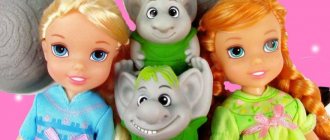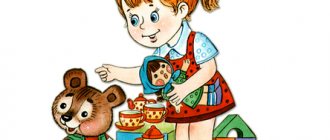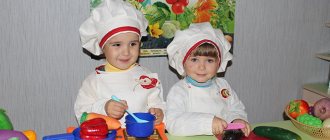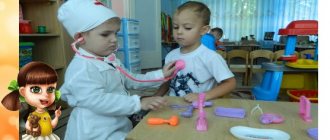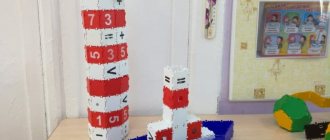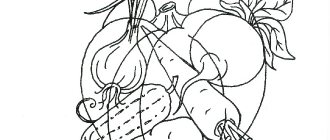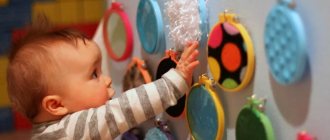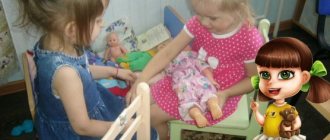Substitute toys for role-playing games for preschoolers. Consultation on the topic
Substitute toys for role-playing games for preschoolers
In preschool age, play becomes the leading activity, but not because the modern child, as a rule, spends most of his time in games that entertain him; play causes qualitative changes in the child’s psyche.
It is often said that a child plays when, for example, he manipulates an object or performs one or another action shown to him by an adult (especially when this action is performed not with a real object, but with a toy). But real play action will occur only when the child means another by one action, and another by one object.
A toy is found not only in a child’s play, but also in the everyday life of an adult. Often a toy is a friend, a life partner, a source of joy, a tool or material for play. The toy presents in a generalized form the typical properties of objects, including people and animals, which require appropriate actions with them. So, for example, a doll is a generalized image of a child that allows children to reproduce a whole range of appropriate actions: bathing, feeding, changing clothes, etc.
Toys are varied in type, material, manufacturing technique, age and educational purpose. The image in toys is conditional and generalized. The nature, degree of generality and convention depend on the type of toy and its specific purpose. Toys are divided into three groups according to the degree of complexity and generality:
- Realistic toys (a dog of a specific breed).
- Conventionally shaped toys (a dog of an unknown breed, a doll as a generalized image of a person).
- Substitute toys (a stick instead of a thermometer, a chair instead of a horse).
When analyzing the features of a preschooler’s play activity, it is necessary to remember that its development is facilitated by the development of the sign function of consciousness, which consists in the ability to use one object as a substitute for another. A prerequisite for mastering the sign function is the mastery of objective actions and the subsequent separation of the action from the object by the preschool child. Therefore, in addition to toys depicting real objects, the child must have objects that can be used as their substitutes: reels, boxes of various shapes, natural materials (cones, acorns, leaves). During the game, the child can give them a new game name and act in accordance with this name. Substitute items also include those that in practical pedagogy are usually called attributes: all kinds of hats, beads, robes, etc. The situation when a child turns a sofa into a steamboat, chairs into train cars, is also an indicator of the development of the sign function of consciousness, and therefore a high level of mental development.
For the development of children's thinking, imagination, speech and in order to raise play to a higher level, various substitute toys are of particular value. For example, when pretending to iron clothes, a child can take not only a toy iron, but also a brick made of building material. Substitute toys can be wooden and plastic circles, rings with a diameter of 3-5 cm, boards, strips of cardboard, substitute items, children’s favorite treats - candies, apples, etc. Together with the teacher, children can make substitute toys and attributes for games - cut out “pancakes”, “cutlets”, “fish”, “vinaigrette” from cardboard, foam plastic, using all this in games that imitate the labor process. By encouraging children to use gaming materials that replace objects that are well known to them, we create a situation in which the child will be faced with the need to designate substitute objects and actions with them in words, which will contribute to his active development.
The value of this toy is that for the first time children independently operate with conventional concepts. Play actions with a substitute toy are based not on visual signs of the object, but on imagined, assumed ones. Using such a toy, the child generalizes his previous gaming experience. A substitute toy requires more schematic generalized play actions and denoting it with a word so that it enters the context of the game and is understandable to others.
Replacement toys are made from a variety of materials. Dolls and animal toys can be made not only from fabric, but also from natural material (straw, wood, grass, etc.). Substitute items are needed from any natural material (chestnuts, pine cones, shells, straw, etc.) For games, you can prepare different sets of toys, united by a common plot. For example, for playing with a doll: doll, blanket, stroller, furniture (bed, table, chair); for playing with a dog toy: a feeding bowl, a sleeping mat, a leash for walking, etc.
For example, if a child is playing with a doll, then instead of it you can offer him a little chick wrapped in a blanket. Playing with such a “doll,” the child shows the missing, but represented by him, the main parts of the human body: the legs at the bottom of the toy, the head at the top. He plays with her as with an ordinary doll, and gradually the word increasingly begins to designate and replace objects that are missing but necessary for the game, their qualities, imaginary properties and states.
How to teach a child to play with such a toy? First, the adult names the substitute toy, and then the child. He calls it as required by the game's design.
The main requirement for a substitute toy is convenience in performing play actions and proportionality with other play material. If conventionally figurative and realistic toys can be bought, then the introduction of substitute toys into children’s play depends on the adult’s imagination, on his penetration into the content of the child’s game. Children watch with great curiosity how an adult, having understood their game plan, creates an object needed for the game from natural material. It is important that the substitute toy resembles the depicted object with general contours or some typical property, a characteristic detail necessary to display game situations (“The kitten” can be made of soft terry cloth, if it is rolled up and tied with a bow “around the neck”; instead bowls for feeding a kitten, you can offer a circle of cardboard, a plastic lid, etc.).
Often children not only enthusiastically use substitute toys offered by adults, but they themselves choose and agree in advance what they will mean: “This is a cat,” “This is a bowl,” “This will be the mother - a big cat, and this is her kitten.” While playing with such toys, the child tries to explain to other children what the substitute object means: “It’s a cat, touch it, it’s so fluffy, you can’t see the eye, it’s probably sleeping.”
Game substitutes for objects may have significantly less similarity with them than, for example, the similarity of a drawing with the depicted reality. However, game substitutes should allow you to act with them in the same way as with the replaced item. Therefore, by giving his name to the chosen substitute object and attributing certain properties to it, the child also takes into account some of the features of the substitute object itself. When choosing substitute objects, the preschooler proceeds from the real relationships of the objects. He readily agrees, for example, that half a match will be a bear, a whole match will be a mother bear, a box will be a bed for a bear. But he will never accept this option, where the teddy bear is a box, and the bed is a match. “It doesn’t happen like that,” is the child’s usual reaction.
So, communication between an adult and a child should be aimed at developing progressive ways of solving game problems for each age period. Children's activities should take place in increasingly complex game problem situations based on practical and play experience. Children who have mastered how to solve the first game problems should complicate the task. For example, not just give the doll tea, but sit it down at the table, prepare lunch first, etc. As children master game problems that are solved visually and effectively (an indicator of which is children's independent play), it is necessary to demonstrate new, more generalized ways of solving them with the help of substitute toys. For example, instead of a plate, offer a doll who really wants to eat a leaf from a tree. Later, children should be shown new ways to solve game problems using drawn objects (an adult takes the soap shown in the picture for bathing, etc.) And finally, it is necessary to show game actions with an imaginary object (give the doll an imaginary apple).
Familiarization with the environment and educational games create the basis for the emergence of play, but children’s independent play is determined by the appropriate organization of the subject-play environment and the activating communication between the adult and the child during the play. Timely changes in the play environment, selection of toys and play material that activates recent impressions in the child’s memory, direct the child to independently and actively solve a play problem, encourage different ways of implementing it and reproducing reality. The object-game environment changes taking into account the practical and play experience of children. It is important to promptly expand not only the range of toys with different themes, but also to promptly supplement the gaming material. An independent story game is formed more successfully if toys are introduced into it gradually (a conventional toy, a more realistic one, a substitute toy). The ability to use substitute objects in play activities is a necessary element in the development of children's play. It is very important to have a “Build It Yourself” construction corner in the group room, which includes sets of various building materials, a Lego-type constructor, a set of cubes; a corner of theatrical activities, where there are masks, bi-ba-bo toys, various costumes for role-playing games; various waste materials: boxes of different shapes and sizes, natural materials, a set of various rags, threads, spools, etc. For example, you can make a table, chairs, a sofa for dolls from cubes and building material, you can make a house and much more. Counting sticks turn into spoons, ladles, pistols and even pasta. Bricks serve as phones, pieces of bread, cakes, and cones turn into delicious ice cream. Beds are made from pieces of fabric, and food is made from cardboard and foam rubber for dolls.
Thus, substitute toys develop the child’s imagination, thinking, speech, and contribute to the development of relationships with peers. The possibility of using substitute items in play activities should be the subject of special discussion between the teacher and parents, since the latter often strive to buy as many ready-made toys as possible, not suspecting that they thereby harm the mental development of the child, in particular his imagination. But all subsequent schooling will be associated with the need to imagine, imagine, and operate with abstract images and concepts. This is, firstly. And secondly, the ability to use various objects (signs) instead of real objects will allow the child to subsequently learn more complex systems of signs, such as language, mathematical symbolism, and various types of art.
TYPES OF TOYS.
- Thematic or figurative toys (dolls, animal figurines, household items).
- Toys - tools (scoop, spatula, net).
- Technical toys with program or non-program control (transport units, machines).
- Game construction sets - prefabricated.
- Didactic toys and games.
- Toys for sports and outdoor games (balls, jump ropes).
- Theatrical and decorative toys (puppet theater characters, costumes, decorations).
- Fun toys.
- Sounding musical toys.
- Game materials and homemade toys.
- Play equipment (houses, layouts).
- Computer toys and games.
- Educational toys (puzzle games).
THE ROLE OF SUBSTITUTE OBJECTS IN THE GAME ACTIVITY OF YOUNGER PRESCHOOL CHILDREN
So, E.E. Kravtsova states that “game is a certain attitude of the world to the child and the child to the world, the child to the adult and the adult to the child, the child to the peer and the peer to him” [5, p. 68]. Gaming activity, in contrast to play, is “a narrower concept; it presupposes special actions of children to model the world” [10, p. 201]. According to D.B. Elkonin, gaming activity includes “stages of its development: need, motive, goal, structure, “stating moments.” The latter, in turn, include an imaginary situation, a game role and the rules of the game” [10, p. 225]. As a rule, the concept of “game activity” is interpreted as a type of activity in situations aimed at recreating and assimilating social experience, in which self-government of behavior is formed and improved [6, p. 5].
Game activity is closely related to objective activity. In the monograph “Psychology of Game” D.B. Elkonin cites data from an experimental psychological and pedagogical study by F.I. Fradkina, confirming the fact that “all the main prerequisites for play arise during the development of the child’s objective activity under the guidance of adults and in joint activities with them” [10, p. 197].
As a result of mastering object actions, a child, under the guidance of an adult, learns the general scheme of action with an object related to its social purpose. According to the results of research by N.Ya. Mikhailenko, F.I. Fradkina, L.S. Slavina, “the path of game development goes from a specific objective action to a generalized game action and from it to a role-playing game action: eating with a spoon; feed with a spoon; feed a doll with a spoon; feeding a doll with a spoon, like a mother, is a schematic way to role-play” [10, p. 218].
Game activity is impossible without a game plan, role-playing actions, and game props. The most important condition for the success of gaming activity is the child’s emotional involvement in the game, awareness of its subjective emotional and entertainment significance. In the article “The Role of Play in Preschool Age” S.O. Kozhakina characterizes the types of story games:
- a game associated with a conditional (game) action in an imaginary situation;
- role-playing game itself (when the child directly takes on a play role around which an imaginary situation is built);
- director's play (when the child is the director, and the toys are actors) [4, p. 24-25].
A mandatory attribute of any game action is a toy. Play equipment allows the child to model an imaginary reality, based on the experience of objective activities and the experience of social interaction with others. The quantity and quality of gaming equipment determine the nature of the game (individual or collective), the form of the game, and the number of participants involved. A toy with a strictly fixed functional purpose establishes a certain set of role-playing actions with the object. The use of such a toy, as a rule, is limited to individual use and deprives potential participants in the game of the opportunity to “attribute” various properties to the game item, determined by the plot content of the game. According to teachers and psychologists, in particular O.A. Stepanova, M.E. Weiner, N.Ya. It is important to note that children’s games should contain “multifunctional play material, i.e. objects that do not have a strict functional purpose (sticks, cubes, etc.), since the finished toy largely inhibits the manifestation of children’s imagination” [9, p. 22].
Text of the book “Child Psychology: A Textbook for Universities”
Psychological significance of a child’s symbolic play substitutions
At an early age, the child is at the mercy of the real situation. This situationality manifests itself at the level of actions, in the child’s statements, in procedural play: the baby uses only objects that are at hand, and for their intended purpose, and reproduces only actions that are already known to him.
After 3 years of age, in developed forms of play activity, the child’s type of behavior changes dramatically. The child begins to act not in a perceived, but in a conceivable, imaginary situation.
Objects are given names and functions that are completely unusual for them. For example, a pencil can become a thermometer, an airplane, or a magic wand. A handkerchief can serve as a blanket, flag, or hat for a doll. Some objects turn into others for the child and replace the missing ones. They become, as it were, symbols of other objects. Such game substitutions are called symbolic.
Symbolic play substitutions that arise at the end of early childhood open up enormous scope for the child’s imagination and, naturally, free him from the pressure of the current situation.
Why is such a sharp leap in a child’s thinking and behavior possible in just a few months? To answer this question, it is necessary, firstly, to consider the features of replacing some objects with others, and secondly, to try to understand where the child gets the opportunity to “symbolically” use objects.
The range of using some objects as others is quite wide, which gives reason for some scientists to believe that in a game everything can be everything, and to see in this a manifestation of the special vividness of children's imagination. However, as observations show, there are certain limits to the playful use of objects, limited at first glance by the external similarity between the object and its substitute. What actually determines these limits?
…
A preliminary answer to this question can be found in the experiments of L. S. Vygotsky, where children were asked to conditionally, as a joke, designate well-known objects with new names. For example, a book meant a house, a pencil meant a nanny, a knife meant a doctor, and keys meant children. Then children 3–4 years old were shown a simple story: a doctor comes to the house, a nanny opens the door for him, he examines the children, gives them medicine, etc. It turned out that all the children easily “read” this story and the similarity of the objects did not play any noticeable role. roles. The main thing is that these objects allow appropriate actions with them.
Things were rejected by the child only if the necessary actions could not be performed with them.
In the experiments of N.I. Lukov, children had to change the names of objects several times during the game and use different toys for different functions. Experiments have shown that the main condition for replacing one toy with another is not external similarity, but the ability to act with it in a certain way. So, for example, you can act with a horse like you would with a child (although it doesn’t look like one at all): you can rock it, comb it, feed it, etc., but you can’t do all these actions with a ball, so a ball in a children’s game cannot portray a child. The physical properties of an object to some extent limit the possibilities of acting with it, so the external similarity or difference of objects can affect their gaming use.
Thus, between the substitute object and its meaning, which is always contained in the word, there is an action,
which determines the connection between a real object and an imaginary one.
…
The relationship between object, action and word was studied in more detail and depth by D. B. Elkonin (1970). One of his studies compared the renaming of objects inside the game (that is, during game actions) and outside it. It turned out that simply changing the name of an object does not cause any difficulties or objections in children. Three-year-old children easily agree to call a dog a car and a box a plate. But in a situation of playful use, resistance to the new name of the object sharply increases, especially if the play action contradicts the child’s experience. For example, in a game it was very difficult for children to call a cube a dog and act with it like a dog, while at the same time they easily accepted actions with a pencil as a knife and willingly used the new name for the pencil.
In the next series of experiments, the divergence between playful and non-playful actions with an object became even stronger: in the same situation, the pencil became a knife, and the knife became a pencil. Children had to “pretend” to cut with a pencil and draw with a knife. But most 3-5 year old children did not accept such a substitution when next to the substitute object there was a real object performing the same function. The introduction of a real object strengthened the connection between perception and action and inhibited the connection between words and action. The child's action under these conditions was stimulated by the perception of the object, and not by its play name.
D. B. Elkonin draws the following conclusion. In order for a word to replace an object and transfer a function from one object to another, it must absorb all possible actions with the object and become the bearer of a system of objective actions.
Under certain conditions (and these conditions arise already at an early age), the connection between a word and an action becomes stronger than the connection between the perceived object and the action. Playing with substitute objects is precisely a unique practice of operating with words, in which the word is separated from the object and becomes the bearer of action.
Thanks to this, in the game, according to L. S. Vygotsky,
“the thought is separated from the thing and the action begins from the thought, and not from the thing.”
But the child cannot yet act on a purely intellectual plane, without carrying out external, practical actions. He must necessarily have a fulcrum in another thing, with which he can perform the same action as with the absent, imaginary object. But is this substitute object a symbol of the absent one and what is a “symbol” in the play of a small child?
According to the position of J. Piaget, who specially studied the play symbolism of a child, an object symbol in a game is an image of the designated object, given in a different material form. With this understanding, the word does not play any active role, since it only repeats what is already contained in the symbol, as in the image of an absent object. However, as the observations and research of D. B. Elkonin showed, substitute items in the game are extremely multifunctional. In addition, their similarity to the designated object can be very relative.
…
A stick, for example, does not resemble a horse at all and is unlikely to evoke the image of a horse. This stick can be not only a horse, but also a snake, a tree, and a gun. It all depends on what word to call it and what meaning the child attaches to it at a particular moment in the game.
Play is not a purely symbolic, mental activity. It is always connected with the real (and not symbolic) interests and experiences of the child.
The psychological meaning of a child’s play substitutions lies not in symbolization, but in the transfer of meaning
(and its corresponding mode of action) from one object to another.
Such a transfer becomes possible thanks to the generalizing function of the word, which absorbs the experience of the child’s actions with an object and transfers it to another object designated by this word. In the game, not only the action is separated from a specific thing, but also the word is separated from the object
to which it was originally assigned (after all, the word-name is initially an integral attribute of the object).
It is as if the structure “object – action – word” is being turned into the structure “word – action – object”. The child begins to act in this way, not because he perceives these objects, but because he himself named
and determined his action.
However, how and under what conditions does a meaning (and a word) separate from an object and transfer it to another object? To answer this question, it is necessary to return to an early age, to the origins of symbolic play, and consider the stages of its formation.
Development of play substitutions at an early age
Numerous studies and observations show that children's play does not arise on its own.
without any guidance from those who already know how to play - adults or older children. Children with whom no one has ever played cannot invent play substitutions themselves and create an imaginary situation. Preschoolers growing up in closed children's institutions, in conditions of a lack of communication with adults, lag significantly behind their family peers in terms of development and timing of the emergence of play. All this may indicate that the origins of play should be sought not in the child’s natural predisposition, but in his relationships with adults. Without special training, play and play substitutions do not arise.
However, this raises the question: how is it possible to teach the game? After all, it is an independent, creative activity of children and cannot in any way be reduced to the acquisition of any specific skills. Unlike weapon actions, play actions do not require any standard methods of action, which means they cannot be acquired in the process of special training.
All this is true, but nevertheless, learning to play is necessary. And it is carried out in the process of playing together with an adult, who conveys to the child the method of replacing some objects with others. In a study by L.N. Galiguzova (1993), the process of developing play substitutions in young children was studied. The experiment used the game situation “caring for a doll.”
…
On the table in front of the child there were realistic toys that allowed for various actions: a crib, a bathtub, a comb, and toy dishes. Among the realistic toys there were also objects with an undefined purpose that could be used in any function (balls, sticks, blocks, etc.). The adult, in front of the child, began to play with these objects, commenting on his actions with words and trying to involve him in his game.
Observations of the child’s behavior made it possible to identify a number of stages in the child’s involvement in the game.
At the first stage, the child does not show any interest in the adult’s substitute actions. In response to an adult’s request to find a missing item (for example: “Let’s give the doll some candy! Where is the candy?”) he either does not answer at all or answers negatively (“There is no candy here”). The child himself uses only realistic toys for their intended purpose.
At the next stage, the child discovers interest in the adult’s substitute actions and immediately after observation imitates them with the same substitute objects. However, this imitation is formal, automatic. The child does not remember which objects he acted with and does not understand the meaning of the substitution. He does not care what objects to perform this or that action with, he easily accepts and reproduces any actions of an adult with any objects. The child “does not hold on” to his own or someone else’s replacement. This may indicate that he does not have a stable image of the object that he replaces in action. Therefore, the substitution is of a formal nature and is not significant for the baby.
At the third stage, the child independently reproduces a delayed imitation of the adult’s substitute actions. At the same time, there is a fairly accurate and complete copying of them and concentration on their implementation. Babies demonstrate attachment to certain substitutions shown by adults and reproduce them with pleasure. But there are no independent replacements yet. An adult's leading questions about new substitutions most often elicit a negative answer, and sometimes the choice of a random object. At this stage, children begin to be more critical of substitute objects. For example, having started feeding a doll with a toothbrush (like a spoon) at the request of an adult, the child suddenly stops and, as if correcting a mistake, takes a toy spoon and begins to feed it, and then brushes the doll’s teeth with a brush. This behavior was not observed at the previous stage, where the baby did not care what to do with the play action. Here the child begins to realize the gap between the object he is familiar with (the designated) and the other one with which he acts instead. It is at this time that children refuse to accept any adult substitutions and agree to only a few.
At the next stage, in the behavior of children, along with imitative ones, independent substitutions appear, representing variations in the actions of an adult. Without going beyond the plot, the child begins to vary the adult’s actions, introducing elements of novelty into them. However, the child’s actions are not yet substitutions in the full sense of the word, since substitutions exist only in movements, but not in the child’s consciousness. When asked by an adult about the names of the objects with which he plays, the child gives their real, not game names. For example, a boy is clearly cooking: stirring something in a saucepan, blowing, tasting. To an adult’s question: “What are you cooking?” - he answers: “Sticks and rings.” There are also double names of objects, for example, “ball - apple” or “ring - cookie,” but these names are very fragile and often fall apart. The real and game functions of objects in such substitutions turn out to be adjacent. There are no independent game naming of objects yet.
It is important to emphasize that at this stage there are already actions with a substitute item, but there is no naming of this item by a game name yet. In the early stages of play development (as opposed to later ones), the child cannot name an object by a new name until he performs the corresponding action with it.
Another important condition for renaming an object in a game is the child’s emotional involvement in the game
and into the actions of an adult. Children accept and repeat a new, playful name for an object only if the adult actively expresses his passion for the game and if the child “gets infected” with this passion. If an adult simply demonstrates new actions with objects and comments on them, children limit themselves to imitation, but never call objects by new names and do not proceed to independent substitutions.
Naming an object with a play name, which occurs at the fifth stage, has the nature of a discovery and significantly changes the nature of the child’s actions. The new meaning of an object fixed in a word seems to revive
this item gives rise to a vivid image of the entire situation of its use. Let us give another example described by L.N. Galiguzova.
…
The girl picks a hole in the oval top of the pyramid with a knife and feeds the doll. An adult asks her: “What does the doll eat?” The girl looks at the object and hesitantly says: “Cookies.” Then he quickly corrects himself: “Testicle!” The adult nods his head in understanding, and she quickly takes a spoon, hits the testicle with it, peels it from the shell, blows on it, saying: “The testicle is hot, it needs to cool down.”
As you can see, the introduction of a word transforms the entire meaning of the situation and the child’s actions. They become more emotionally intense, focused and relevant to the imagined situation. After the first playful renaming of an object, which is often an acceptance (and not just a repetition) of the adult’s renaming, it is as if a new, conventional way of acting with objects is discovered.
The child begins to introduce his own, sometimes original, substitutions into the game. Renaming objects moves to the beginning of the game action and becomes more conscious.
Thus, the development of play substitutions at an early age goes through the following stages: 1) observation of an adult’s play; 2) joining this game, playing together; 3) imitation of the actions of an adult; 4) independent delayed imitation with the appearance of variability in play actions; 5) the emergence of independent game substitutions. These stages reflect the turn from direct imitation of others’ actions to the child’s own actions,
which are mediated by a sign as an “instrument of culture,” i.e., a word;
action arises from a word (or from a thought), and not from a thing. This turn occurs with the active and direct participation of an adult. The substitution function, like any other mental function, is first divided between the child and the adult and exists in an interpsychic form, and then is appropriated by the child and becomes his intrapsychic function.
The introduction of a sign (i.e., renaming an object) transforms an externally perceived situation into a semantic one for the child. Perception is mediated by the word, and old objects are filled with new meaning. The transition from direct action to indirect action occurs in the unity of the affective and intellectual: the transfer of the meaning of one object to another is possible only with the child’s emotional involvement in the game and with the affective significance of the game actions.
The emergence of elements of creativity in the play of young children
Talking about creativity in relation to young children may seem strange. After all, creativity in general is considered as an activity, the result of which is the creation of new material and spiritual values, giving rise to something new that did not previously exist. However, looking at the problem of creativity from the point of view of child psychology forces us to clarify this understanding. L. S. Vygotsky wrote that creativity manifests itself wherever a person imagines, changes, deviates from the stereotype, creates even a grain of something new for himself or others. From this point of view, we can and should talk about creative manifestations even in early childhood, and the first manifestations of children's creativity appear in children's play,
and mainly in substitutive actions.
The play of children of the second year of life is mainly reproductive in nature: their actions are entirely determined by the visual situation and the demonstration of an adult. The use of substitute objects is purely imitative and is poorly understood by the child.
In the third year of life, the game, according to L.N. Galiguzova, undergoes significant changes, which are as follows:
firstly, gaming motivation increases
and the child’s emotional involvement in the game: the duration of the game increases, the child shows various emotions more clearly and more often, the independence of play actions and their independence from the adult increases significantly;
secondly, the composition of game actions changes significantly.
Not only the mastery of gaming skills and the number of gaming actions increases, but also their
variability.
The isolated actions of two-year-olds are being replaced by consistent and independent development of the schemes of one plot. So, in order to prepare lunch for a doll, a child can, within 15–20 minutes, cut vegetables, put them in a pan, stir, taste, set the table, etc. Let us remember that the baby in the same situation quickly brought a spoon to the doll’s mouth ;
thirdly, and perhaps most importantly, substitutions are firmly included in the repertoire of children’s play behavior.
Most children at the end of the 3rd year of life easily replace some objects with others and themselves give them appropriate names.
These substitutions are often quite original inventions of the children's own. They are the first “products” of children's creativity.
So, by the end of early childhood, a new way of acting for children with substitute objects develops. The child begins to clearly see the similarities and differences between the denoting and the designated object; the choice of a substitute object ceases to be random - the baby first looks for a suitable object and only then gives it a new name. The awareness, independence and originality of children's substitute actions allow us to consider them as manifestations of children's imagination. The new freedom to operate with images of objects and their designations (words) allows the child to restructure the visual situation as a whole, break out of its boundaries and create his own plot of the game.
L.N. Galiguzova describes the following example of such restructuring:
…
“Natasha (2 years 11 months), after playing with the doll, suddenly moves all the toys to the side, takes two saucers and puts a cube on them and places an oval pyramid piece on each. Turning to the adult, he says: “These are the windows (cubes), and these are the koloboks that are drying.” Then Natasha takes them off and puts a flat plastic triangle in their place: “Here is the bridge, cars pass here.” Having closed one of the openings with another designer part, he announces: “The garden is closed, do not pass through.” He takes a spoon and depicts a car with it, moves along the bridge: “Doo-doo-doo.” Then he says sternly, turning to the spoon: “The garden is closed, where are you going?” Having removed the spoon, the girl repeats the same with the stick...”, etc.
In this example, the child plays without relying on realistic toys, freely replacing one object with another. Here the game already acts as a completely independent activity, independent of the adult, in which the child is free from the visual situation and creates his own imaginary world.
When introducing substitute objects into the game, the teacher must not only carry out play actions with them (bring a spoon-stick to the doll’s mouth, soap the bear with soap cube), but also verbally designate the conditional object (“This is our soap”, “It’s as if spoon”, etc.), the meaning of the action performed with it (“I’ll wash the bear’s paws, the soap lathers well,” etc.), do this repeatedly during the game, so that the convention of the game object and action is more fully apparent to the child. It is during this period that verbal comments from an adult are especially necessary, since without them the conditional action may remain incomprehensible to the child. At the same time, children themselves should be encouraged to designate play actions with words (“What do you feed your doll? Oh, is that your bread?”, etc.).
It is important to keep in mind that young children tend to use a substitute object in independent activity precisely in the conventional meaning in which it was used by an adult in a joint game with children (for example, instead of a spoon, only a stick is used, and it is the one that was introduced into the game an adult; a child, playing independently, can specifically look for her). Therefore, in future joint games with children, the teacher should expand the range of actions with substitute objects: use the same object to perform different game actions, that is, give it different conventional meaning (for example, in one game a stick is used as a spoon, in another - the same stick - a thermometer, in the third - a comb, etc.); use different substitute objects to perform the same game action (for example, for the first time in the game a cube is taken instead of soap, the next time - a flat box, a block, etc.).
One should also take into account the fact that children, especially young children, need realistic object supports to develop play: story toys that copy real things. If you provide a child with only substitute objects without story toys, it will be difficult for him to grasp the meaning of a play situation even in a joint game with an adult, and his independent activity will be reduced to simple manipulation of objects. Therefore, the substitute object should always be combined with a plot toy (if bread is replaced by a cube, then the plate on which it lies should be “like a real one”; if soap is replaced by a bar, then a toy basin is needed in which to wash, etc. ).
Psychological significance of a child’s symbolic play substitutions
After three years of developed forms of play activity, the child’s type of behavior changes dramatically. Children begin to act not in a perceived, but in a conceivable, imaginary situation.
Objects are given names and functions that are completely unusual for them.
For example, a pencil can become a thermometer, or an airplane, or a magic wand. Therefore, such game substitutions are called symbolic.
Symbolic play substitutions that arise at the end of early childhood open up enormous scope for the child’s imagination and, naturally, free him from the pressure of the current situation.
In the experiments of L. S. Vygotsky, where children were asked to conditionally, as a joke, designate well-known objects with new names. For example, a book meant a house, a pencil meant a nanny, a knife meant a doctor, and keys meant children. Then children 3-4 years old were shown a simple story: a doctor comes to the house, the nanny opens the door for him, he examines the children, gives them medicine, etc. It turned out that all the children easily “read” this story, and the similarity of the objects did not play any noticeable role. roles. The main thing is that these objects allow appropriate actions with them. Things were rejected by the child only if the necessary actions could not be performed with them.
In the experiments of N.I. Lukov, children had to change the names of objects several times during the game and use different toys for different functions.
The results showed that the main condition for replacing one toy with another is not external similarity, but the ability to act with it in a certain way. So, for example, you can act with a horse like you would with a child (although it doesn’t look like one at all): you can rock it, comb it, feed it, etc., but you can’t do all these actions with a ball, so a ball in a children’s game cannot portray a child.
Thus, between the substitute object and its meaning, which is always contained in the word, there is an action, which determines the connection between the real object and the imaginary.
The relationship between object, action and word was studied in more detail and depth by D. B. Elkonin. Interpreting the results of observations of children's play, he draws the following conclusion: in order for a word to be able to replace an object and transfer a function from one object to another, it must absorb all possible actions with the object, become the bearer of a system of objective actions (1978, p. 242 ). According to L. S. Vygotsky, “thought is separated from the thing, and action begins from the thought, and not from the thing” (1966, p. 69). But the child cannot yet act on a purely intellectual plane, without carrying out external, practical actions.
According to the position of J. Piaget, who specifically studied the play symbolism of a child, an object symbol in a game is an image of the designated object, given in a different material form. With this understanding, the word does not play any active role, since it only repeats what is already contained in the symbol as in the image of an absent object. However, as observations and studies have shown
D. B. Elkonin, substitute items in the game are extremely multifunctional.
In addition, their similarity to the designated object can be very relative. A stick, for example, does not resemble a horse at all and is unlikely to evoke the image of a horse. She can be not only a horse, but also a snake, a tree, and a gun. It all depends on what word to call it and what meaning the child attaches to it at a particular moment in the game.
The psychological meaning of a child’s play substitutions lies not in symbolization, but in the transfer of meaning (and the corresponding method of action) from one object to another. Such a transfer becomes possible thanks to the generalizing function of the word, which absorbs the experience of the child’s actions with an object and transfers it to another object designated by this word. In the game, not only the action is separated from a specific thing, but also the word is separated from the object to which it was originally assigned (after all, the word-name is initially an integral attribute of the object). There is a kind of reversal of the structure “object-action-word” into the structure “word-action-object”. The child begins to act in exactly this way, not because he perceives these objects, but because he himself named and thereby determined his action.
The emergence of elements of creativity in the play of young children
However, looking at the problem of creativity from the point of view of child psychology forces us to clarify this understanding. L. S. Vygotsky wrote that creativity manifests itself wherever a person imagines, changes, deviates from the stereotype, creates even a grain of something new for himself or for others. From this point of view, we can and should talk about creative manifestations even in early childhood, and the first manifestations of children's creativity appear in children's play,
and mainly in substitutive actions.
The play of children of the second year of life is mainly reproductive in nature: their actions are entirely determined by the visual situation and the demonstration of an adult.
According to L.N. Galiguzova, in the third year of life the game undergoes significant changes, which are as follows:
1) gaming motivation increases
and the child’s emotional involvement in the game: the duration of the game increases, the child shows various emotions more clearly and more often, the independence of play actions and their independence from the adult increases significantly;
2) the composition of game actions changes significantly .
Not only the mastery of gaming skills and the number of gaming actions increases, but also their
variability.
3) substitutions are firmly included in the repertoire of children’s play behavior.
Most children at the end of the third year easily replace some objects with others and give them the appropriate names themselves. These substitutions are often quite original inventions of the children.
They are the first “products” of children's creativity.
So, by the end of early childhood, a new way of acting for children with substitute objects has developed. The child begins to clearly see the similarities and differences between the denoting and the designated object; the choice of a substitute object ceases to be random - the baby first looks for a suitable object and only then gives it a new name. The awareness, independence and originality of children's substitute actions allows us to consider them as manifestations of children's imagination.
